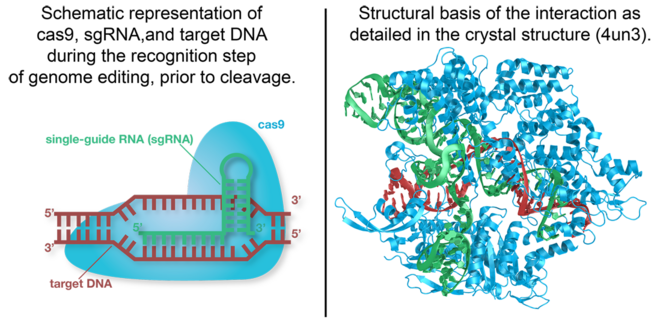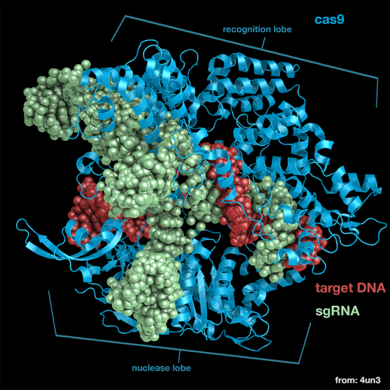Cas9 Sandbox
From Proteopedia
Function
Cas9 is the RNA-guided DNA endonuclease used by the CRISPR (clustered regularly interspaced short palindromic repeats)-associated systems to generate double-strand DNA breaks in the invading DNA during an adaptive bacterial immune response. Three different types of CRISPR mechanisms have been discovered, however, only type II CRISPR systems are heavily researched. In vivo, Cas9 requires CRISPR RNA (crRNA) and trans-activating crRNA (tracrRNA) to guide the endonuclease toward invading DNA based on the complementary sequence recognition of these RNAs. Cas9 then targets and cleaves foreign DNA to interfere with viral replication and integration into the host's genome. The CRISPR-associated endonuclease has been exploited for use in genome editing systems. In such systems, an engineered single-guide RNA (sgRNA) is used to perform the function of crRNA-tracRNA complex to target double-stranded breaks in genomic DNA. Depending on what repair pathway is triggered, often dictated by the inclusion of additional engineered components, the targeted site either is disrupted or incorporates additional genetic sequences. [1]
Structural highlightsCas9 is a structurally bilobed, containing specific domains for the recognition of target DNA and nucleases to cleave DNA strands. Each of these lobes contain three major units essential for a functional endonuclease, these are the essential . The (REC) contains a long bridge helix, the REC-1 domain and the REC-2 domain. It is also the least conserved lobe through the types of Cas9. The long , which is arginine-rich, is essential for recognizing single guide RNA-DNA complexes on target DNA. This structure has been shown to be conserved through Cas9 proteins. The domain contains 25 α-helixes and two β-sheets, and is crucial to the function of Cas9 by recognizing a specific motif termed the repeat:anti-repeat region of the single guide RNA and DNA complex. The domain contains six α-helix’s in a bundle but there is no current understanding of its function. The nuclease lobe (NUC) contains a RuvC domain, HNH domain and the PAM-interacting domain (PI). The RuvC domain is comprised of three RuvC motifs that are made up of two-stranded antiparallel β-sheets, and six-stranded β-sheets, which are flanked by nine α-helices. The cleaves the non-complementary, single stranded DNA. This nuclease is active through the use of four catalytic residues shown in the previous scene. The is composed of a two-stranded antiparallel β-sheet which is flanked by four α-helixes and cleaves the complementary strand of target DNA. The four catalytic residues of this nuclease domain are highlighted in red. The is made up of seven α-helixes and numerous strand-varying antiparallel β-sheets which recognize the PAM sequence on the non-complementary target DNA strand.[2]
DNA InteractionTarget DNA contains a protospacer adjacent motif on the non-complementary strand, which constitues the . This canonical sequence of 5’-NGG-3’ is recognized by Cas9 and is essential for genetic interference and editing, therefore, it will not cleave the target sequence if the PAM sequence is absent. The double Guanine of the non-complementary sequence strand interacts via hydrogen bonding from the major groove through two conserved arginine residues on the carboxy-terminus of Cas9 [3]. The minor groove of the PAM sequence interacts with a serine, through a hydrogen bridge to the last guanine, and lysine residue on the complementary target strand of the middle guanine. The deoxyribose-phosphate backbone of the non-complementary strand is arranged in close proximity to various hydrogen bonding atoms, some of which are accomplished through water molecules, and ionic interactions. A phosphate lock loop provides local strand separation upstream of the PAM sequence when a Lysine and Serine residue stabilize target DNA. The PAM sequence recognition of Cas9 is an integral function of its specific binding, subsequent base pair melting and cleavage of target DNA.
LimitationsDespite the many advantages of CRISPR/Cas9 it still has two major limitations. The first is that CRISPR/Cas9 requires the presence of an NGG PAM. NGG PAM occurs approximately every 8bp causing it CRISPR/Cas9 to have less target sequence density than TALENS. This lower precision compared to TALENS may lead to CRISPR/Cas9 being used less in cases where a DSB needs to be targeted in smaller sequences. The next limitation is the use of DSBs. If cleavage occurs at an off-target site the genome can experience unexpected perturbations. As CRISPR/Cas9 and other genome editing methods move to a more clinical use these perturbations could increase the risk of developing tumors.[4] Medicinal ApplicationsThe CRISPR/Cas9 system has shown efficiency in treating viral infections that alter the host organisms' genome. HIV-1 is an example of a virus that may reside in an individual in a dormant state called a latent reservoir. [5] In this state, the viral DNA is not being transcribed into RNA, and the effects of the infection are nonexistent; however, the virus may begin transcribing its DNA at any time which would lead to the symptoms of HIV infection. The CRISPr/Cas9 system was successful at eradicating the HIV-1 virus from the infected individual, and also cleaving the viral DNA out of the hosts' genome, thus not allowing for later infection. Ethical ControversyThe use of the Crispr/Cas9 has undergone much scrutiny. Those who are opposed to the use of Cas9 in the Crispr system for genome editing claim that the technology will ultimately lead to "designer babies," and we shouldn't alter the genomes of future generations without their consent. The National Institutes of Health has stated that they will not fund any gene-editing technologies for use on human embryos.
References
3D structures of Cas9Streptococcus pyogenes Cas9
Actinomyces naeslundii Cas9See Also | ||||||||||||


